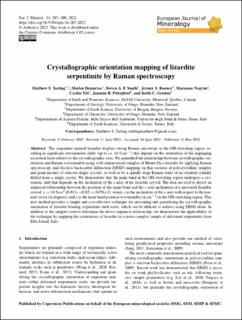| dc.contributor.author | Tarling, Matthew S. | |
| dc.contributor.author | Demurtas, Matteo | |
| dc.contributor.author | Smith, Steven A.F. | |
| dc.contributor.author | Rooney, Jeremy S. | |
| dc.contributor.author | Negrini, Marianne | |
| dc.contributor.author | Viti, Cecilia | |
| dc.contributor.author | Petriglieri, Jasmine R. | |
| dc.contributor.author | Gordon, Keith C. | |
| dc.date.accessioned | 2022-06-27T06:31:36Z | |
| dc.date.available | 2022-06-27T06:31:36Z | |
| dc.date.created | 2022-05-18T14:09:15Z | |
| dc.date.issued | 2022 | |
| dc.identifier.issn | 0935-1221 | |
| dc.identifier.uri | https://hdl.handle.net/11250/3000935 | |
| dc.description.abstract | The serpentine mineral lizardite displays strong Raman anisotropy in the OH-stretching region, resulting in significant wavenumber shifts (up to ca. 14.5 cm−1) that depend on the orientation of the impinging excitation laser relative to the crystallographic axes. We quantified the relationship between crystallographic orientation and Raman wavenumber using well-characterised samples of Monte Fico lizardite by applying Raman spectroscopy and electron backscatter diffraction (EBSD) mapping on thin sections of polycrystalline samples and grain mounts of selected single crystals, as well as by a spindle stage Raman study of an oriented cylinder drilled from a single crystal. We demonstrate that the main band in the OH-stretching region undergoes a systematic shift that depends on the inclination of the c-axis of the lizardite crystal. The data are used to derive an empirical relationship between the position of this main band and the c-axis inclination of a measured lizardite crystal: y=14.5cos 4 (0.013x+0.02)+(3670±1), where y is the inclination of the c-axis with respect to the normal vector (in degrees), and x is the main band position (wavenumber in cm −1) in the OH-stretching region. This new method provides a simple and cost-effective technique for measuring and quantifying the crystallographic orientation of lizardite-bearing serpentinite fault rocks, which can be difficult to achieve using EBSD alone. In addition to the samples used to determine the above empirical relationship, we demonstrate the applicability of the technique by mapping the orientations of lizardite in a more complex sample of deformed serpentinite from Elba Island, Italy. | en_US |
| dc.language.iso | eng | en_US |
| dc.publisher | Copernicus Publications | en_US |
| dc.rights | Navngivelse 4.0 Internasjonal | * |
| dc.rights.uri | http://creativecommons.org/licenses/by/4.0/deed.no | * |
| dc.title | Crystallographic orientation mapping of lizardite serpentinite by Raman spectroscopy | en_US |
| dc.type | Journal article | en_US |
| dc.type | Peer reviewed | en_US |
| dc.description.version | publishedVersion | en_US |
| dc.rights.holder | Copyright Author(s) 2022 | en_US |
| cristin.ispublished | true | |
| cristin.fulltext | original | |
| cristin.qualitycode | 1 | |
| dc.identifier.doi | 10.5194/ejm-34-285-2022 | |
| dc.identifier.cristin | 2025265 | |
| dc.source.journal | European Journal of Mineralogy | en_US |
| dc.source.pagenumber | 285-300 | en_US |
| dc.identifier.citation | European Journal of Mineralogy. 2022, 34 (3), 285-300. | en_US |
| dc.source.volume | 34 | en_US |
| dc.source.issue | 3 | en_US |

